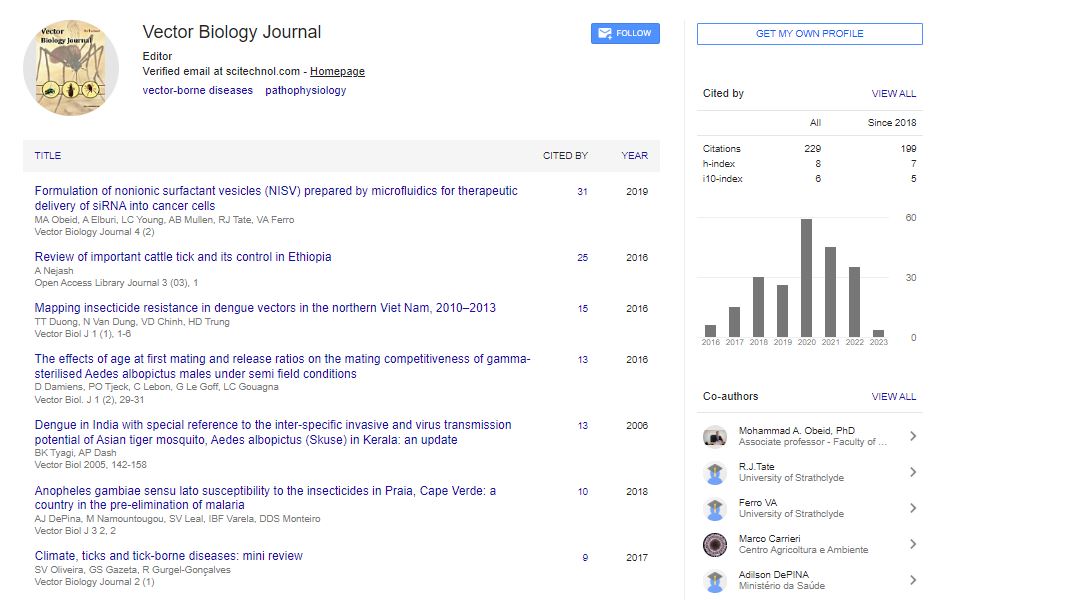Perspective, Vector Biol J Vol: 8 Issue: 4
Mechanism of Vector-Borne Diseases and its Methods for Control
Rozal Vincent*
1Department of Psychology, University of Nevada, Las Vegas, USA
*Corresponding Author: Rozal Vincent,
Department of Psychology, University of
Nevada, Las Vegas, USA
E-mail: vincent.ro@gmail.com
Received date: 21 November, 2023, Manuscript No. VBJ-24-127804;
Editor assigned date: 23 November, 2023, PreQC No. VBJ-24-127804 (PQ);
Reviewed date: 07 December, 2023, QC No. VBJ-24-127804;
Revised date: 15 December, 2023, Manuscript No. VBJ-24-127804 (R);
Published date: 22 December, 2023, DOI: 10.4172/2473-4810.1000275.
Citation: Vincent R (2023) Mechanism of Vector-Borne Diseases and its Methods for Control. Vector Biol J 8:4.
Description
Vector-Borne Diseases (VBDs) represent a significant responsibility on global public health, affecting millions of people around the world and providing difficulties for disease control and prevention efforts. These diseases, transmitted to humans through the bites of arthropod vectors such as mosquitoes, ticks, and sandflies, include malaria, dengue fever, Zika virus, Lyme disease, and others.
The epidemiology of vector-borne diseases is influenced by a myriad of factors, including vector species, host populations, environmental conditions, and socio-economic determinants. Climate change, urbanization, deforestation, and globalization have contributed to the emergence and re-emergence of vector-borne diseases, altering vector habitats, distribution patterns, and disease transmission dynamics. Additionally, socio-economic factors such as poverty, inadequate housing, and limited access to healthcare exacerbate the burden of VBDs on vulnerable populations, particularly in resourcelimited settings.
Malaria, caused by Plasmodium parasites and transmitted by Anopheles mosquitoes, it is one of the most significant vector-borne diseases globally, with an estimated 229 million cases and 409,000 deaths reported in 2019. The burden of malaria is significantly borne by sub-Saharan Africa, where high transmission intensity and limited access to healthcare contribute to the persistence of the disease. Efforts to control malaria include vector control measures such as insecticidetreated bed nets and indoor residual spraying, as well as diagnosis and treatment with antimalarial drugs.
Dengue fever, transmitted by Aedes mosquitoes, it is another major vector-borne disease, with an estimated 390 million infections occurring annually worldwide. Dengue is endemic in over 100 countries, primarily in tropical and subtropical regions, where urbanization and inadequate sanitation establish optimal conditions for mosquito breeding. Control efforts focus on vector surveillance, habitat management, and community engagement to reduce mosquito populations and minimize disease transmission. Additionally, the development of dengue vaccines provides a ensuring methods to disease prevention in endemic areas.
Zika virus, transmitted primarily by Aedes mosquitoes, gained global attention during the 2015-2016 outbreaks in the Americas, highlighting the potential for emerging vector-borne diseases to spread rapidly and impact public health on a global scale. Zika virus infection during pregnancy is associated with adverse birth outcomes, including microcephaly and other congenital abnormalities, underscoring the importance of surveillance, prevention, and control efforts to mitigate the impact of emerging VBDs on vulnerable populations.
Lyme disease, transmitted by Ixodes ticks, it is the most common vector-borne disease in the United States and Europe. The incidence of Lyme disease has been increasing in recent years, driven by factors such as land use changes, suburbanization, and the expansion of tick habitats. Control measures for Lyme disease focus on tick methods for avoiding, including the use of insect repellents, wearing protective clothing, and conducting tick checks after outdoor activities. Additionally, early diagnosis and treatment with antibiotics are essential for preventing complications associated with Lyme disease.
Challenges in the control of vector-borne diseases include insecticide resistance, limited access to diagnostic tools and treatments, and gaps in surveillance and reporting systems, particularly in resource-limited settings. Additionally, the complex interplay between vectors, hosts, pathogens, and environmental factors presents difficulties to effective disease control and prevention efforts. Addressing these difficulties requires a multi-disciplinary method, integrating biomedical, ecological, social, and environmental perspectives to develop comprehensive techniques for VBD control and elimination.
Global collaboration and coordination are essential for tackling the complex difficulties presented by vector-borne diseases. Initiatives such as the World Health Organization's Global Vector Control Response and the Global Vector Hub facilitate information sharing, capacity-building, and resource mobilization to support VBD control efforts in endemic countries. Furthermore, investments in study and innovation are essential for developing new tools and techniques for vector control, diagnostics, and treatments, as well as for manage the increasing difficulties caused by vector-borne illnesses.
 Spanish
Spanish  Chinese
Chinese  Russian
Russian  German
German  French
French  Japanese
Japanese  Portuguese
Portuguese  Hindi
Hindi 